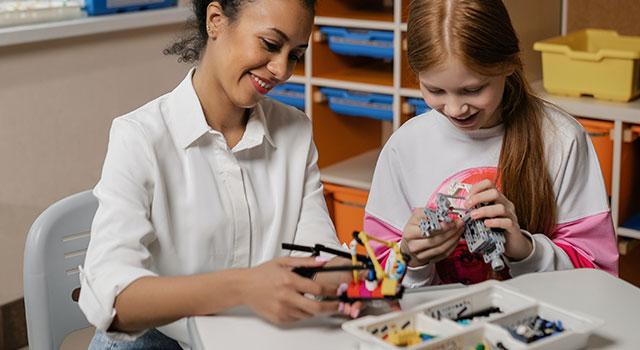
If your child is showing signs of a learning difficulty, it is important to rule out an underlying vision problem that may be hindering their ability to successfully complete the tasks required for academic achievement.
Early detection of a vision problem is crucial for preventing years of learning difficulties and feelings of frustration and reduced self-esteem. Contact Aspire Vision Care to book a comprehensive eye exam and assess whether any underperforming visual skills may be interfering with your child's academic achievement.
Below are a few ideas of toys and games that promote children’s visual skills.
Building Toys
Building toys fuels the imagination develops spatial awareness and spatial organization skills. These skills are useful in understanding maps, geography and geometry, and solving math problems. Spatial awareness is also essential for sports and dancing.
When children build with toys, they also develop hand-eye coordination, problem-solving skills and visualization skills.
Popular building toys include Legos, Lincoln Logs, Duplos, Mega Bloks, Magnatiles and Clics.
Games for Visual Processing
Children develop visual processing and reasoning by playing checkers, chess, dominoes and Rush Hour.
Memory games require players to identify pairs from memorized pictures, develop cognitive and visual skills. Puzzles and games strengthen visual skills [utilized] in geometry, math problems and reading comprehension.
Visual processing skills are essential not only in school but in life. They help us navigate using written directions, detect visual patterns, gather clues from the world around us and notice essential details.
Spatial Awareness Games
Spatial awareness is the process by which people become aware of themselves and other objects in the space around them. This is important for developing peripheral vision and a range of visual skills. Playing “ball” sports such as baseball, soccer, tennis, basketball and ping pong develops space perception and hand-eye coordination. These games require a fast reaction and an exact perception of the location of any object around you and how far or close the object is.
In addition to sports, marbles and pick-up sticks also encourage three-dimensional depth perception, which can also improve visual skills such as eye-tracking, eye muscle coordination and focusing.
A Child’s Vision Is Vital for Fun and Learning
Vision involves more than just seeing clearly. It gives children the confidence to join in games and participate in school. Often what appears to be a lack of interest in studies or behavior difficulties can be caused by underdeveloped visual skills.
School vision screenings are rudimentary and aren’t designed to assess a child’s visual skills. Even a child with 20/20 vision can have visual skills deficits.
If you suspect your child is struggling in school, bring them to Aspire Vision Care for a functional vision evaluation.
If an issue with visual functioning is detected, your eye doctor can map out a personalized therapeutic program to suit your child’s needs. Research supports vision therapy as an effective treatment for a wide range of functional vision problems. Vision therapy is like a gym that trains the brain and the eyes to work together and improve eye-brain-body coordination.
For more information or to schedule a functional vision evaluation, call Aspire Vision Care today.
Our practice serves patients from Round Rock, TX, Pflugerville, Cedar Park, and Georgetown, Texas and surrounding communities.
Q: How common are vision problems in children?
- A: According to the World Health Organization (WHO), 2 out of every 1,000 people under the age of 25 have a vision impairment and 5.6% of children with learning disabilities have poor visual skills.
Q: What eye conditions can vision therapy treat?
- A: Vision therapy is a non-surgical, personalized program that corrects vision problems in children and adults. The following conditions are commonly treated using vision therapy:
- Amblyopia or lazy eye
- Strabismus or irregular eye alignment
- Binocular vision problems
- Focusing problems

